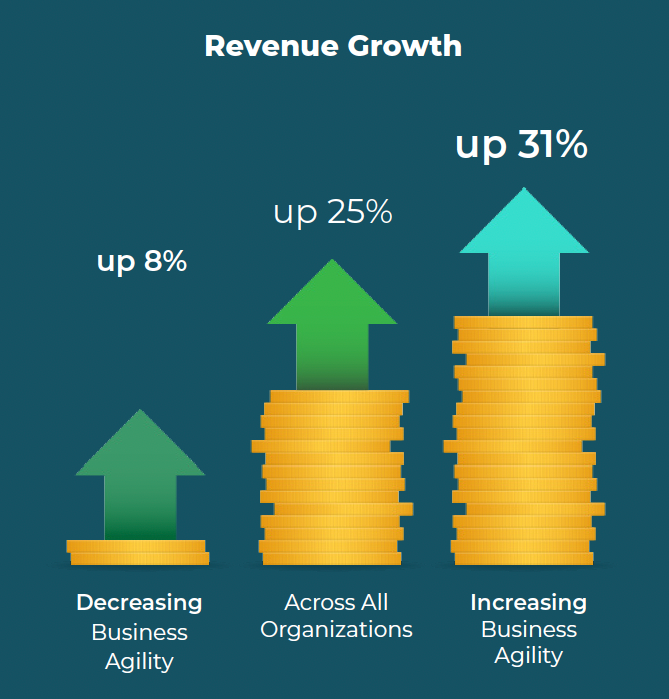Human-Centric Organizations Drive Revenue: 2024 Business Agility Report
Volatile. Uncertain. Complex. Ambiguous. VUCA.
It’s a term long-cited within the ALJ community, and it just might be the most accurate way to describe the world today, and within it, the human-centered organizations we lead.
So how are leaders guiding teams through constant change today? Further, how will they keep them engaged and motivated as we tip-toe into the unknown that 2025 will bring?
The recently published
2024 Business Agility Report might give us some clues. It highlights what’s working and where leaders will need to focus in the coming year as they continue to build agile, resilient organizations.
“One key trend in 2024 is the renewed focus on customer-centric, human-centered operations. Top-performing companies are making agility a core business practice, not just a one-time transformation project. More organizations are also improving their entire business, rather than focusing on a single division or department.
For me, one standout finding is the 35% average improvement in organizations’ ability to prioritize—a critical skill in today’s demanding environment, where time and resources are limited.”
— Laura Powers, CEO, Business Agility Institute
From fostering trust and psychological safety to empowering teams with accountability, this year’s report shows that creating an environment where people can thrive is key to handling disruption. Here’s a closer look at how leaders can use them to strengthen their teams and drive meaningful change.
People-First Leadership and Employee Engagement
Despite People-First Leadership being the smallest area of growth, there was upward movement in fostering authentic relationships and realizing people’s potential—these saw improvements of 12% and 11%, respectively, over the previous year.
If you’re wondering why this modest increase is important, there is a good reason: These areas are shown to significantly
impact CEO approval ratings, which in turn correlate with
improved employee engagement. Further, the presence and balance of empowerment with accountability creates high-performing environments where
employees are motivated and engaged.
Culture of Transparency and Psychological Safety
The report reveals that capabilities tied to an Engaged Culture saw substantial improvement, particularly in transparency and psychological safety. Acting as One, a key aspect of organizational unity, rebounded with a remarkable 28% increase from 2023, underscoring the power of collaborative problem-solving in agile teams. Engaging Transparently and Courageously saw a 23% rise, reflecting the growing importance of open communication.
The Role of Leadership in Shaping Culture and Mindset
Outdated leadership capabilities continue to be the most cited obstacle to achieving business agility. Leaders who fail to model desired changes or demonstrate commitment to the agility transformation tend to perpetuate resistance and traditional mindsets within their organizations. The report suggests that leaders must align their actions with organizational agility goals to avoid undermining transformation efforts and to inspire broader cultural shifts.
Notably, organizations that excel in Flexible Operations—especially the ability to Fund Work Dynamically and (Re)organize Structures Fluidly—saw these areas improve by 16% and 18%, respectively—suggesting that leaders who champion flexibility inspire more adaptable, cohesive cultures.
Still a Struggle: Change Fatigue and Clear Transformation Goals
New this year saw many organizations sharing that unclear, contradictory, or missing goals were significantly hindering their journey toward business agility. Successful transformations are often led by the Board or C-suite rather than isolated departments, with the most successful organizations (42% of respondents) reporting transformation across all functions. One respondent said succinctly, “[Leaders don’t] understand this means change for everyone, not just ___ department.” Having clear, organization-wide transformation goals helps unify efforts across functions.
Benefits of Human-Centric Agility
Organizations that adopt human-centric agility report tangible benefits, including increased revenue, customer satisfaction, and higher employee engagement. For example, companies with strong business agility saw a 31% year-over-year increase in revenue per employee, as well as a higher percentage of employees recommending their organization. 0This underscores that people-focused agility drives not only cultural benefits but also financial and operational success.
Organizations with Increasing Business Agility Experience a Higher Revenue Growth Rate
Organizations that increased their business agility maturity saw revenue per employee increase by 31% year-over-year (on average).
While those organizations whose maturity in business agility decreased over that period, saw a much smaller 8% year-over-year (on average) increase in revenue per employee.
Putting people at the center of leadership isn’t just good for culture—it’s good for business too. By building trust, encouraging transparency, and staying flexible, leaders can keep their teams motivated and resilient while driving meaningful results like higher engagement, innovation, and revenue.








